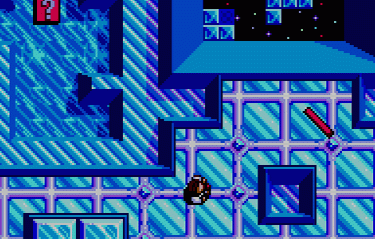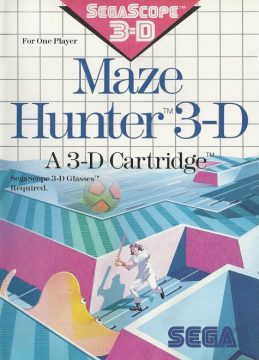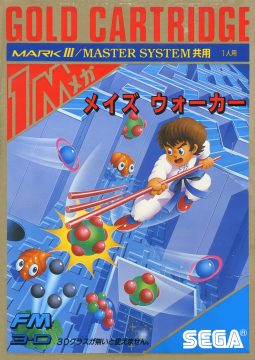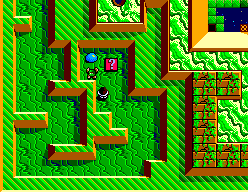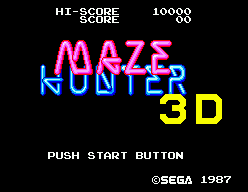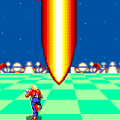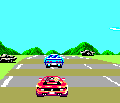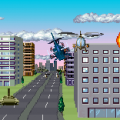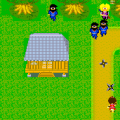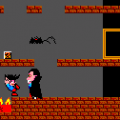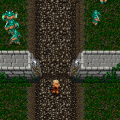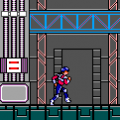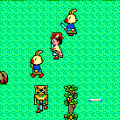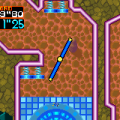Maze Hunter 3D is one of the seven Master System titles released for the SegaScope 3D Glasses. The accessory wasn’t exactly a success, partly due to its high price (about $50 US), but also due to the middling quality of the games that used it. Maze Hunter 3D doesn’t exactly do much to change that reputation.
The plot states that there is a legendary, mysterious labyrinth floating somewhere out in space. You, an intrepid explorer, happen to get trapped inside of it. The hero is unnamed in the English version, but is given the name Lee in the Japanese version.
The goal in each level is not only to find the exit, but also to find the key to unlock it. On its own, this isn’t too hard – the levels in Maze Hunter 3D are only mazes by the loosest definition of the word. There are lots of twists and turns, but there are usually only a few branching paths, and the maps aren’t too large, so it’s hard to actually get lost. In fact, most of them can be reduced to a simple binary decision – pick wrong and you’ll end up at the exit, requiring you to double back, take the other path, get the key, and then head back to the exit. The mazes are typically divided into three tiers, to show off the 3D effect. Teleport to a lower tier, and both your character and the enemies appear deeper in the screen.
By default, you have no weapons. You just shuffle forward and avoid getting killed by the many monsters roaming the maze. Eventually you’ll find some important power-ups, including your main weapon, an unwieldy red pipe, along with jumping shoes, and suits that can either make you walk faster, or absorb a single hit. Once per stage, a balloon also flies by, which you can whack providing you have both the bar and the jumping shoes. This will give some sort of temporary power-up, which includes a few types of projectile weapons, and an item that can destroy everything on the screen. These are handy, but they’re of limited use, especially since the guns seem to have a brief lag whenever you fire, making it hard to hit anything during the short time you can use it.
Maze Hunter 3D is one of those games that doesn’t seem like it should be particularly hard, but it is. This mostly has to do with the erratic enemy movement. Many foes have distinct behavior, which you can predict to either avoid or kill them, but some move around completely randomly. Coupled with both the short range and unwieldiness of your weapon (you can only attack in four directions), it turns most encounters with even simple enemies into harrowing battles. This is doubly true if you don’t have a weapon, and either have to jump over or try to run around them.
Enemy placement is also random. They’re kind enough to blink for a second or so before they become active, and it’s always tempting to try to whack them before they have a chance to act, but it’s just as easy to misjudge the hit, end up attacking air, and then get mauled yourself. Coupled with the fact that you lose your weapon, shoes, and suits when you get killed, the tables can be turned on you very quickly for one minor screw-up.
Overall, there’s not really much to Maze Hunter 3D. There aren’t any bosses, and the enemies just get slightly harder as the game goes on. By pure gameplay standards, it’s boring in concept, with too much trudging around, and frustrating in execution. Even so, it’s worth remembering for a few reasons.
For starters, the graphic design is just crazy. The first zone, with its blue, robotic corridors (the Metal area) is quite boring, but the later levels, particularly the blazing red titles of the Volcano zone, or the green landscape of the Jungle zone, are fine displays of the Master System’s bright color palette. The enemy design is also incredibly bizarre, with odd objects like polka-dotted balls and evil clams, that would be cute in a Fantasy Zone game, but given their chaotic nature, end up rather intimidating. On this note, it’s interesting to compare the cover art between the Japanese and overseas versions. The American version features what appears to be a mullet-wearing tennis player fending off a giant manta ray; the same scene in the Japanese version is presented as an anime dude leaping away from a brown leaf with eyes.
The 3D effects are also outstanding. Most of the other SMS 3D games featured first person or over-the-shoulder perspectives. As a purely overhead game, Maze Hunter 3D isn’t as immediately impressive, since it’s not really tossing anything directly at the player (except when he jumps up). The 3D effects add plenty of depth to every surface of the maze, though, and it would’ve been great to see this applied to more interesting games.
Many stages have the exit on the lowest tier of level, where the hero is only a tiny speck. Here, the exit is often suspended over open space; with no rails and very little margin for error, it’s extremely easy to slip off the edge, watching as your hapless character silently falls into the void as the music slowly fades before the level restarts. Similarly, when an enemy kills you, you turn into a halo and wings, and float up to the screen. This is the game at its best—just weirdly terrifying.
In at least its initial SMS release, this is one of the few titles where 3D can’t be disabled. It makes sense – the game is barely worth playing without it. (It can be deactivated through the use of codes with a third party device, or through an emulator.)
Maze Hunter 3D was ported to the 3DS on the Sega 3D Classics Collection retail release (the second volume released in Japan, but the only one released in North America and Europe). This also contains a 2D mode, as well as some options that make the game easier, like the ability to save/load states, along with a 30-man code. The 3D effect is even more stunning here, especially since you don’t need to use any 3D glasses.
